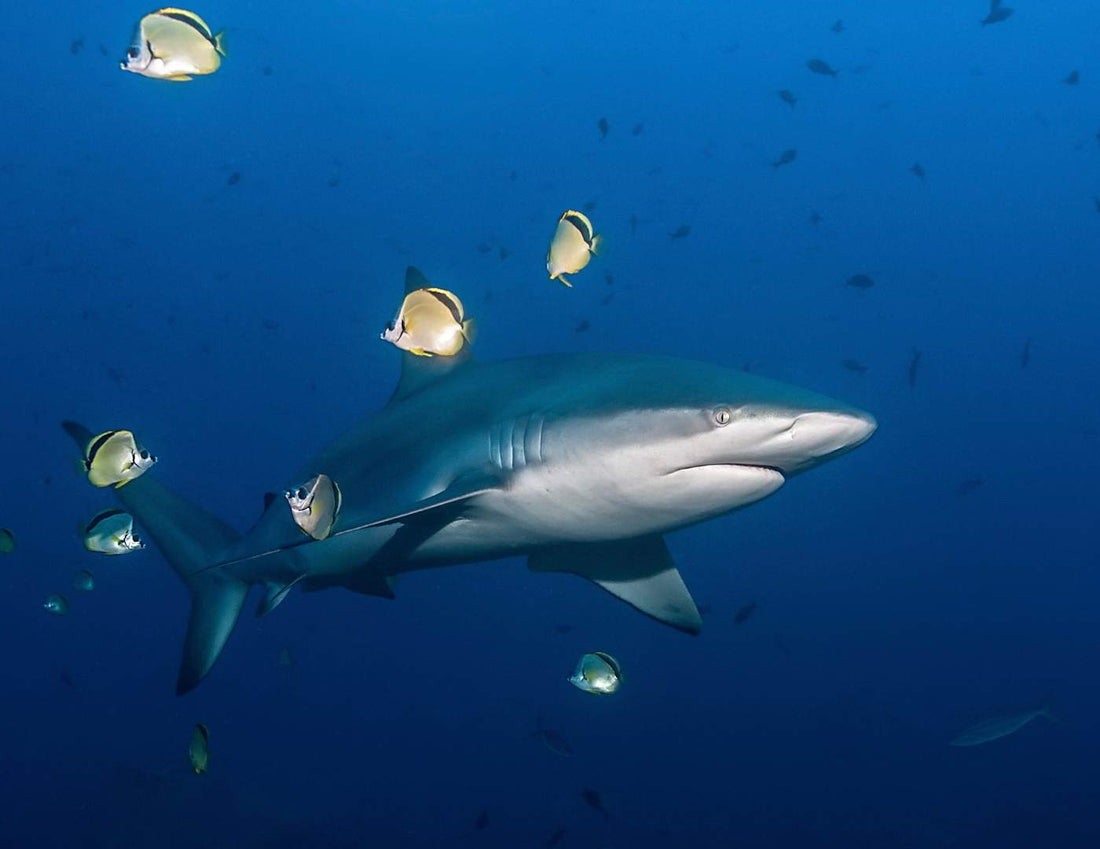
Reef Shark Species: How to Identify and Protect Them
BY NAMUBAKShare
Reef sharks are fascinating predators that play a crucial role in the health of marine ecosystems. Although often misunderstood, these sharks are indicators of healthy reefs and act as guardians of ecological balance .
There are several species that inhabit shallow tropical areas, and each has unique behavioral, dietary, and adaptive characteristics.
In this guide, we show you how to recognize them, why they're important, and what we can do to preserve them.
Most common reef shark species
Whitetip reef shark (Triaenodon obesus)

The whitetip reef shark , also known as the whitetip reef shark , is a reef specialist. Unlike its more active relatives, this shark is nocturnal and typically spends the day resting on the seafloor, in crevices or caves within the reef.
It is a discreet but efficient species. At night, it hunts with smooth, precise movements, using its slender, flexible body to explore the tightest corners of the coral. Its stealthy hunting strategy makes it one of the most effective predators in the reef ecosystem.
It is commonly seen resting in small groups during the day, making it one of the few shark species that can remain motionless without needing to constantly swim to breathe.
How to recognize it?
Its elongated, slender, gray-brown body ends in fins with clearly defined white tips , especially on the dorsal fin and the upper tail lobe. Its snout is short and rounded, giving it an unmistakable appearance.
How does it behave?
It's calm, methodical, and non-aggressive. It's generally inactive during the day, but at night it transforms into a stealthy hunter. It's arguably the nocturnal reef shark , adept at silently patrolling its surroundings.
| Attribute | Detail |
|---|---|
| Scientific name | Triaenodon obesus |
| Common names | Whitetip shark, Whitetip reef shark |
| Coloration | Brownish gray with white belly and white tips on dorsal and caudal fins |
| Size | Up to 1.6 meters (5.2 feet) |
| Natural habitat | Coral reefs, lagoons, crevices, reef edges |
| Distribution | Indo-Pacific Region: Red Sea, Indian Ocean, Central Pacific |
| Conservation status | Near Threatened (IUCN) |
Blacktip reef shark (Carcharhinus melanopterus)

The blacktip reef shark is a classic tropical reef dweller. Graceful, swift, and easily recognized by its distinctive black-tipped fins, it often glides among shallow corals with a presence that commands respect.
Although it can sometimes appear intimidating, those who have seen it up close know that it is more elusive than aggressive. Its shy behavior leads it to quickly move away at the slightest human movement. It is frequently observed near the coast at snorkeling sites, moving gracefully along sandbanks and protected lagoons.
Thanks to its agility and versatile diet—based on small fish, squid, and crustaceans—it plays a fundamental role in the balance of the coral ecosystem.
How to recognize it?
The distinctive black tips on its fins , especially the dorsal fin, give it away even before you see its entire body. Its silhouette is streamlined, with gray tones on its back and a white belly.
How does it behave?
It's fast, cautious, and highly sensitive to its surroundings. It's arguably the reef's introvert , always alert and ready to disappear among the corals.
| Attribute | Detail |
|---|---|
| Scientific name | Carcharhinus melanopterus |
| Common names | Blacktip shark, Blacktip shark |
| Coloration | Brownish gray with a white belly and black tips on the fins |
| Size | Up to 2 meters (6.6 feet) |
| Natural habitat | Coral reefs, lagoons and shallow sandy areas |
| Distribution | Indo-Pacific Region: Red Sea, East Africa, Southeast Asia |
| Conservation status | Near Threatened (IUCN) |
Gray reef shark (Carcharhinus amblyrhynchos)

The gray reef shark is an imposing predator, known for its robust body, territorial nature, and speed. It is commonly seen patrolling reef edges, especially in deep areas or near steep drops in the seafloor.
Its presence conveys authority. Unlike other, more timid species, this shark actively defends its territory and doesn't usually back down from a threat, especially if food is nearby. Even so, its behavior with humans is generally more cautious than aggressive.
Its ecological function is key : it maintains the balance of species on reefs by controlling fish and invertebrate populations.
How to recognize it?
Its elongated, slender, gray-brown body ends in fins with clearly defined white tips , especially on the dorsal fin and the upper tail lobe. Its snout is short and rounded, giving it an unmistakable appearance.
How does it behave?
It's calm, methodical, and non-aggressive. It's generally inactive during the day, but at night it transforms into a stealthy hunter. It's arguably the nocturnal reef shark , adept at silently patrolling its surroundings.
| Attribute | Detail |
|---|---|
| Scientific name | Triaenodon obesus |
| Common names | Whitetip shark, Whitetip reef shark |
| Coloration | Brownish gray with white belly and white tips on dorsal and caudal fins |
| Size | Up to 1.6 meters (5.2 feet) |
| Natural habitat | Coral reefs, lagoons, crevices, reef edges |
| Distribution | Indo-Pacific Region: Red Sea, Indian Ocean, Central Pacific |
| Conservation status | Near Threatened (IUCN) |
Galapagos Reef Shark (Carcharhinus galapagensis)

The Galapagos shark is a powerful and robust predator, commonly observed in remote oceanic areas and near volcanic islands. It takes its name from the Galapagos Islands, where it is frequently found, but it also inhabits other tropical regions around the world.
It is a highly curious and territorial species, exhibiting behaviors that can seem challenging, especially when moving in groups. Despite its size and intensity, it is not typically aggressive toward humans, although it deserves respect and distance, like any large predator.
Its role as the top species in the food chain makes it a key regulator of marine populations. It can feed on bony fish, rays, cephalopods, and even other smaller sharks.
How to recognize it?
It has a large, strong body, uniformly gray in color with a white belly. Its fins are wide, with faint dark edges . The snout is rounded, and its dorsal fin is well developed, located near the center of the body.
How does it behave?
It is inquisitive, dominant, and adaptable. It is frequently seen swimming in deep water or near underwater cliffs. It is an ocean explorer , capable of traveling vast distances and adapting to different island environments.
|
Attribute |
Detail |
|---|---|
| Scientific name | Carcharhinus galapagensis |
| Common names | Galapagos shark |
| Coloration | Uniform brown-grey with white belly; fins with faint dark edges |
| Size | Up to 3.3 meters (10.8 feet) |
| Natural habitat | Oceanic islands, deep slopes, continental shelves |
| Distribution | Tropical Pacific Ocean: Galapagos, Hawaii, remote islands of the world |
| Conservation status | Near Threatened (IUCN) |
Caribbean reef shark (Carcharhinus perezi)

The Caribbean reef shark is one of the most iconic species of the western Atlantic. Its elegant figure, curious behavior, and constant presence on reefs make this shark a frequently observed species by divers in places like Belize, the Bahamas, and the southern Caribbean off Costa Rica.
It is considered sociable and exploratory , frequently approaching diving groups, more out of curiosity than aggression. Although it is an active predator, its behavior is generally calm, and its presence is synonymous with a healthy reef.
At night, it becomes more active as a hunter. Its diet includes fish such as grouper and snapper, as well as squid, octopus, and occasionally crustaceans.
How to recognize it?
It has a streamlined, silvery-gray body with a white belly. Its fins often have indistinct dark edges . Its snout is rounded, and its dorsal fin is tall and triangular, giving it a distinguished profile as it patrols the reef.
How does it behave?
Curious, confident, and active. They're often seen swimming alone or in small groups, exploring areas near reefs or underwater cliffs. They could be considered the extrovert of the reef , always attentive to what's going on around them.
| Attribute | Detail |
|---|---|
| Scientific name | Carcharhinus perezi |
| Common names | Caribbean reef shark, Reef shark |
| Coloration | Silvery gray with white belly; faint dark edges on fins |
| Size | Up to 3 meters (10 feet) |
| Natural habitat | Coral reefs, coastal plains and reef drop-offs |
| Distribution | Western Atlantic: Caribbean, Gulf of Mexico, Bahamas, South Caribbean of Costa Rica |
| Conservation status | Near Threatened (IUCN) |
How to identify reef sharks?
Observing sharks in their natural environment is an unforgettable experience. But correctly identifying each species requires attention to detail: body shape, color, size, fins, and behavior are key to accurately distinguishing them.
Below, we share an infographic with the most relevant characteristics of the most common reef shark species.

Observing and recognizing reef sharks not only enriches our experiences at sea, it also connects us with the importance of protecting them. Each species plays a vital role in the balance of the ocean. Understanding them is the first step toward their conservation.

